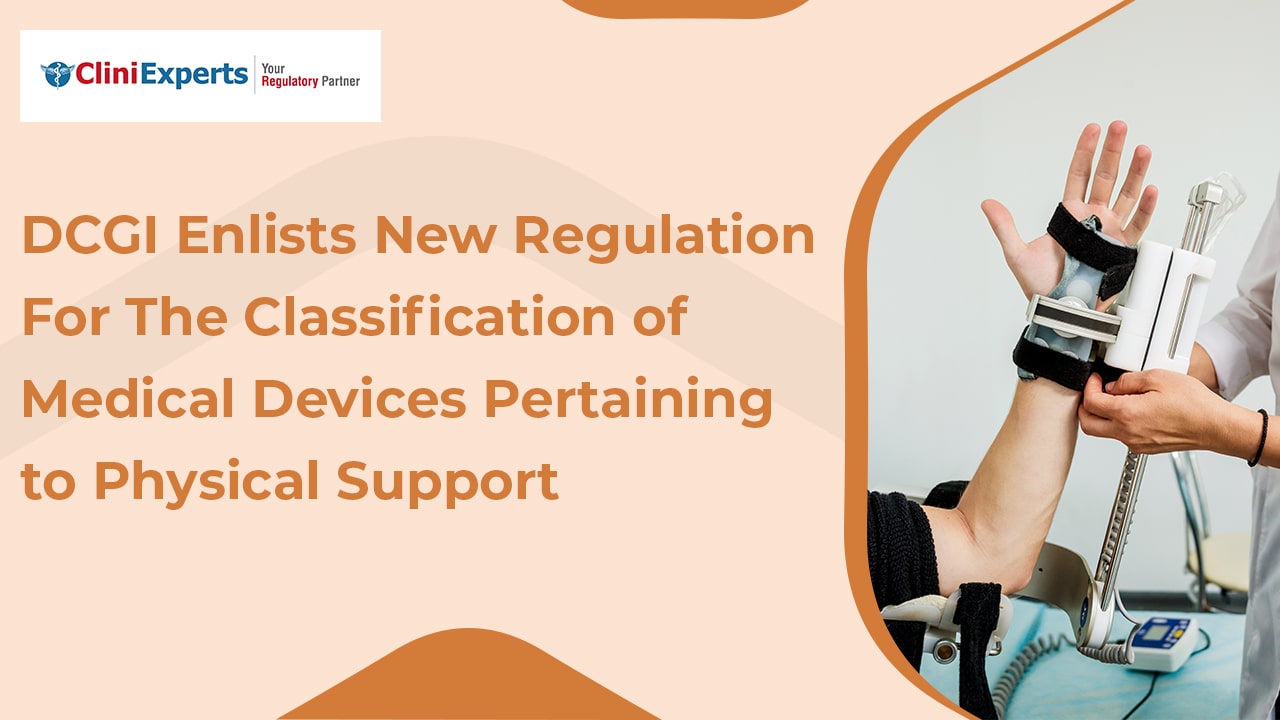DCGI Enlists New Regulation For The Classification Of Medical Devices Pertaining Of Physical Support

Drugs and Cosmetics Act, 1940, and Rules regulates all new medical device’s safety, quality, and performance. The Central Government has notified the new Medical Devices Rules, 2017 vide G.S.R. 78E dated January 31, 2017, to regulate the import, manufacture, clinical investigation, sale, and distribution of medical devices.
DCGI enlists new classification for Medical Devices pertaining to Physical Support
The Drugs Controller General (India) (DCGI), Directorate General of Health Services, has classified medical devices pertaining to Physical Support. DCGI implemented this classification on July 26, 2021.
Classification of medical device
Under the provisions of Medical Devices Rules, 2017, medical devices are classified into four risk classes, i.e., Risk Class A, B, C, and D. Tables 1, 2, and 3 lists all medical devices and their classification pertaining to Physical Support. The majority of the medical devices are listed under Risk class A whereas Risk Class C and D contain only one medical device each.
| Risk class A |
| Ankle/foot orthosis |
| Balance board |
| Bed traction frame |
| Body arch traction table |
| Canalith repositioning procedure chair, manual |
| Cervical spine collar |
| Cervicothoracic spine orthosis |
| Cervicothoracolumbosacral spine orthosis |
| Collar and cuff arm sling material |
| Cranial orthosis |
| Elbow orthosis |
| Finger orthosis |
| Foot orthosis |
| Hand orthosis |
| Hand/finger splint |
| Horizontal non-powered traction system |
| Incentive spirometer |
| Kinetic bed |
| Knee immobilizer |
| Orthopaedic bed |
| Paediatric dorsiflexion slant board |
| Parapodium walking frame |
| Shoulder immobilizer |
| Swivel-walker |
| Toe separator |
| Wrist immobilizer |
| Risk Class B |
| Ankle continuous passive motion exerciser |
| Chest-oscillation airway secretion clearing system |
| Flotation therapy bed, adult |
| Flotation therapy bed, neonatal |
| Hand/wrist continuous passive motion exerciser |
| Hip/knee continuous passive motion exerciser |
| Intermittent traction system |
| Physical therapy massager |
| Shoulder continuous passive motion exerciser |
| Traction table, line-powered |
| Risk Class C | Risk Class D |
| Neuro-controlled ambulation exoskeleton | Cervical spine immobilization head ring |
Factors associated with the classification of medical devices
As per the sub-rule (3) of rule 4 of Medical Devices Rules, 2017, the DCGI has classified medical devices pertaining to physical support based on the following factors:
- Intended use.
- Risk factors.
- Other parameters as per the First Schedule of Drugs and Cosmetics Ace, 1940
The classification is subjected to changes
As per the provisions of Medical Devices Rules, 2017, the intended use for the medical devices is to guide the applicants during the import or manufacture of the medical devices. Additionally, the classification of medical devices pertaining to Physical Support can revise from time to time.
Summary:
- The Drugs Controller General (India) has listed a new classification of medical devices pertaining to Physical Support from July 26, 2021.
- The classification is based on the device’s intended use, risk, and other parameters listed in the First Schedule.
- This classification can revise from time to time.
References
- Classification of Medical Devices pertaining to Physical support under the provisions of Medical Devices Rules, 2017-Reg. Accessed on Aug 8, 2021
Recent Posts
Organic Food Labelling In India| Certification, and Import of Organic Food in India

This Article is All About Organic Food Labelling In India and Certification, and Import of Organic Food in India. Explained in Detail About What is Organic Food labelling? Summary Short Description Wi..
Cosmetic Label Compliance India : A Guide to Compliance

Introduction Looking for Cosmetic Label Compliance India? Are you a cosmetic manufacturer or importer navigating the complex world of Indian regulations? Ensuring your product labels comply with the l..
Clinical Investigation Approvals: An Overview of Forms MD-22 and MD-23

Summary Short Description Strict regulatory protocols govern clinical investigations for medical devices. Central to this process are forms MD-22 and MD-23. Form MD-22 is an application to Central Lic..
HAVE A QUERY?
REACH US!Office
New Delhi
Unit No. 324 & 325, City Centre Mall, Plot No. 5, Sector 12, Dwarka, India - 110075
+917672005050
Bengaluru
RMZ Galleria, 1st floor, Ambedkar Colony, Yelahanka, Bengaluru, Karnataka, India – 560064
Call us on
Sales: +91 7672005050
Reception: +91-11-45214546
Timings
9 am to 6 pm (Monday to Friday)


